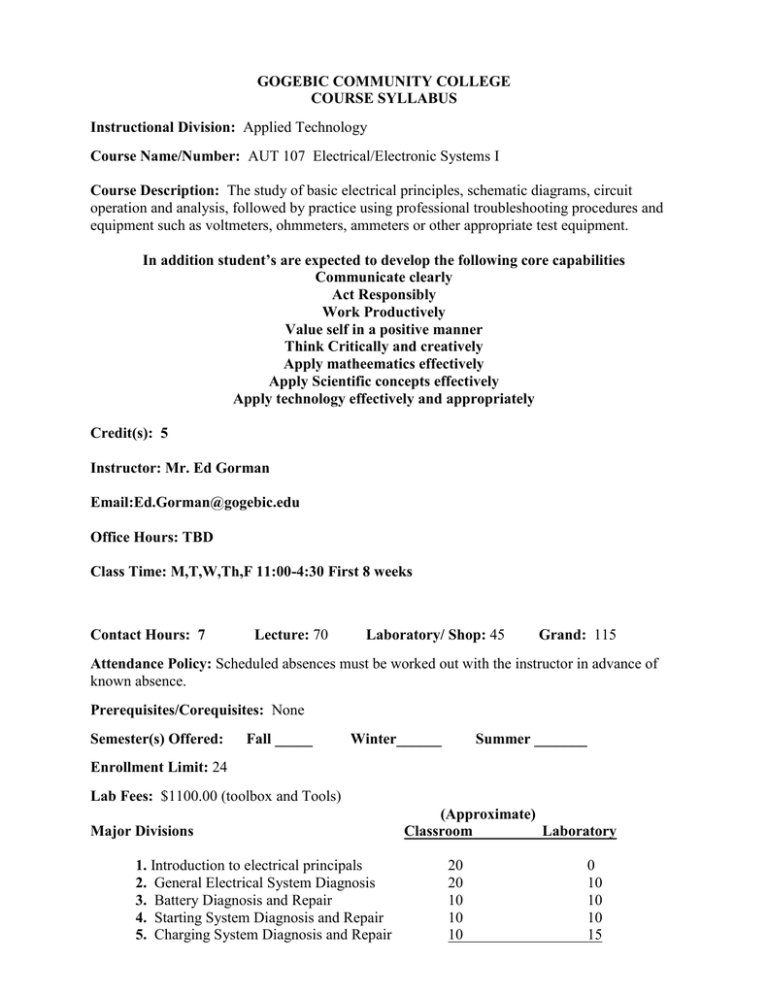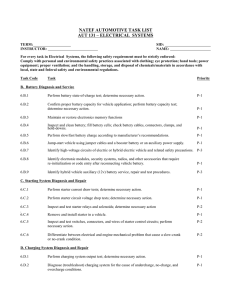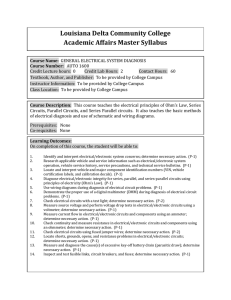AUT 107 - Gogebic Community College
advertisement

GOGEBIC COMMUNITY COLLEGE COURSE SYLLABUS Instructional Division: Applied Technology Course Name/Number: AUT 107 Electrical/Electronic Systems I Course Description: The study of basic electrical principles, schematic diagrams, circuit operation and analysis, followed by practice using professional troubleshooting procedures and equipment such as voltmeters, ohmmeters, ammeters or other appropriate test equipment. In addition student’s are expected to develop the following core capabilities Communicate clearly Act Responsibly Work Productively Value self in a positive manner Think Critically and creatively Apply matheematics effectively Apply Scientific concepts effectively Apply technology effectively and appropriately Credit(s): 5 Instructor: Mr. Ed Gorman Email:Ed.Gorman@gogebic.edu Office Hours: TBD Class Time: M,T,W,Th,F 11:00-4:30 First 8 weeks Contact Hours: 7 Lecture: 70 Laboratory/ Shop: 45 Grand: 115 Attendance Policy: Scheduled absences must be worked out with the instructor in advance of known absence. Prerequisites/Corequisites: None Semester(s) Offered: Fall _____ Winter______ Summer _______ Enrollment Limit: 24 Lab Fees: $1100.00 (toolbox and Tools) Major Divisions 1. Introduction to electrical principals 2. General Electrical System Diagnosis 3. Battery Diagnosis and Repair 4. Starting System Diagnosis and Repair 5. Charging System Diagnosis and Repair (Approximate) Classroom Laboratory 20 20 10 10 10 0 10 10 10 15 Total: 70 45 Performance Objectives: ASE performance objectives adopted and attached. Required Textbooks/Workbooks and Instructional Aides: Author: James D. Halderman Publisher:Pearson Halderman Automotive TechnologyPrinciples, Diagnosis and Service ISBN 10: 0-13-265395-8 ISBN 13: 978-0-13-265395-4 CLASSROOM POLICIES: A. Attendance: Attendance is required! You are allowed 3 abcenses, absence number 4 automatically fails you in the class Lecture: If you miss a class period, you are still required to learn the materials presented. Lab/ Shop: Attendance is mandatory. Please do not schedule appointments during any part of the three hour block scheduled for lab. If you must miss a laboratory/ shop period, notify the instructor the week before so that make up work can be planned. B. Examinations: Exams are to be taken at the scheduled times unless arrangements are made in advance. The only exams that will be announced in advance are mid-terms and final exams. I reserve the right to give quizzes at anytime with no prior notice to students C. Extra Credit: Extra Credit will be at the discression of the instructor. D. Grading: : Grading is based on a total points scenario. It is important for you to understand that because of the large number of competencey tasks that need to be performed they will constitute a much larger portion of your grade than Exams, Tests or quizzes will. Therefore it is imperative that you use your time wisely and perform competency tasks whenever possible. Grades will be assigned according to the following percentages of points earned: A 90 – 100% B 80 – 89% C 70 – 79% D 60 – 69% F Below 60% Further more grades will be determined in this fashion Class participation 10% EXAMS 10% Quizzes 10% Shop/Competency grade 70% Once your grade is determined your final grade will be determined by the Gogebic Community college grading scale *As students in this program you must understand that academic grades earned in the classroom will by no means ensure successful completion of the course. These classes are performanced driven and as such a large emphasis is placec on being able to complete the tasks but also to explain the underlying theory as well . ADA Accommodation for Students with Disabilities If you believe that you need academic accommodations for a disability that qualifies under the Americans with Disabilities Act and Section 504 of the Rehabilitation Act, please contact the Office of Disability Services, located in office T105C of the ACES Center, call (906) 932.4231 x 237, or e-mail jessicaln@gogebic.edu to discuss your needs and the process for requesting accommodations. This office is responsible for coordinating disability-related academic accommodations and will issue students with verification letters as appropriate. Since accommodations may require early planning and generally are not provided retroactively, please contact the office as soon as possible. F. Academic Honesty: Students are encouraged to work together in the exchange of ideas, discussion of assignments, and when preparing for tests, but anything (homework, lab report, etc.) turned in for credit must be the individual student’s own work. Don’t copy from another person. If you choose to copy another person’s work, you and the person you copied from will fail the assignment. Subsequent copying will result in a failing grade for the course. Anyone caught cheating during an exam will automatically receive a failing mark for the course. Turning in work from any website, book, magazine, etc. as your own is plagiarism and constitutes automatic failure on the assignment and potentially the course. AUT 107 Electrical/ Electronic Systems Performance Objectives: ELECTRICAL/ELECTRONIC SYSTEMS For every task in Electrical/Electronic Systems, the following safety requirement must be strictly enforced: Comply with personal and environmental safety practices associated with clothing; eye protection; hand tools; power equipment; proper ventilation; and the handling, storage, and disposal of chemicals/materials in accordance with local, state, and federal safety and environmental regulations. VI. ELECTRICAL/ELECTRONIC SYSTEMS A. General Electrical System Diagnosis 1. Complete work order to include customer information, vehicle identifying information, customer concern, related service history, cause, and correction. P-1 2. Identify and interpret electrical/electronic system concern; determine necessary action. P-1 3. Research applicable vehicle and service information, such as electrical/electronic system operation, vehicle service history, service precautions, and technical service bulletins. P-1 4. Locate and interpret vehicle and major component identification numbers. P-1 5. Diagnose electrical/electronic integrity of series, parallel and series-parallel circuits using principles of electricity (Ohm’s Law). P-1 6. Use wiring diagrams during diagnosis of electrical circuit problems. P-1 7. Demonstrate the proper use of a digital multimeter (DMM) during diagnosis of electrical circuit problems, including: source voltage, voltage drop, current flow, and resistance. P-1 8. Check electrical circuits with a test light; determine necessary action. P-2 9. Check electrical/electronic circuit waveforms; interpret readings and determine needed repairs. P-2 10. Check electrical circuits using fused jumper wires; determine necessary P-2 action. 11. Locate shorts, grounds, opens, and resistance problems in electrical/electronic circuits; determine necessary action. P-1 12. Measure and diagnose the cause(s) of excessive parasitic draw; determine necessary action. P-1 13. Inspect and test fusible links, circuit breakers, and fuses; determine necessary action. P-1 14. Inspect and test switches, connectors, relays, solenoid solid state devices, and wires of electrical/electronic circuits; perform necessary action. P-1 15. Remove and replace terminal end from connector; replace connectors and terminal ends. P-1 16. Repair wiring harness (including CAN/BUS systems). P-1 17. Perform solder repair of electrical wiring. P-1 18. Identify location of hybrid vehicle high voltage circuit disconnect (service plug) location and safety procedures P-2 VI. ELECTRICAL/ELECTRONIC SYSTEMS B. Battery Diagnosis and Service 1. Perform battery state-of-charge test; determine necessary action. P-1 2. Perform battery capacity test; confirm proper battery capacity for vehicle application; determine necessary action. P-1 3. Maintain or restore electronic memory functions. P-1 4. Inspect, clean, fill, and/or replace battery, battery cables, connectors, clamps, and hold-downs. P-1 5. Perform battery charge. P-1 6. Start a vehicle using jumper cables or an auxiliary power supply. P-1 7. Identify high voltage circuits of electric or hybrid electric vehicle and related safety precautions. P-3 8. Identify electronic modules, security systems, radios, and other accessories P-1 that require reinitialization or code entry following battery disconnect. 9. Identify hybrid vehicle auxiliary (12v) battery service, repair and test procedures. VI. ELECTRICAL/ELECTRONIC SYSTEMS P-3 C. Starting System Diagnosis and Repair 1. Perform starter current draw tests; determine necessary action. P-1 2. Perform starter circuit voltage drop tests; determine necessary action. P-1 3. Inspect and test starter relays and solenoids; determine necessary action. P-2 4. Remove and install starter in a vehicle. P-1 5. Inspect and test switches, connectors, and wires of starter control circuits; perform necessary action. P-2 6. Differentiate between electrical and engine mechanical problems that cause a slow-crank or no-crank condition. P-2 VI. ELECTRICAL/ELECTRONIC SYSTEMS D. Charging System Diagnosis and Repair 1. Perform charging system output test; determine necessary action. P-1 2. Diagnose charging system for the cause of undercharge, no-charge, and overcharge conditions. P-1 3. Inspect, adjust, or replace generator (alternator) drive belts, pulleys, and tensioners; check pulley and belt alignment. P-1 4. Remove, inspect, and install generator (alternator). P-1 5. Perform charging circuit voltage drop tests; determine necessary action. P-1 Attendance policy Addendum 11/12/2012 1. You will be given a 15 minute grace period from the start of class to be in the classroom and in your seat ready to participate. 2. 30 minutes late- you will be docked ½ day of attendance 3. 1hour late- you will be docked an entire days’ attendance. 4. There will be no exceptions to these rules, when you arrive late constantly you are interrupting the learning process for other students and this will not be tolerated in the Automotive Technology Classes. Compare it to work if you were to not call in or show up you would be fired the next day no questions asked. Ed Gorman Jon Werkmeister Signature_____________________________________




